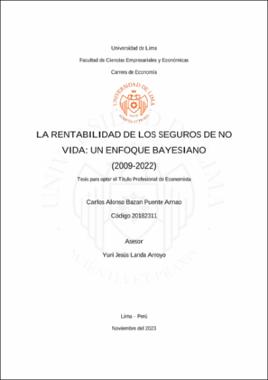La rentabilidad de los seguros de no vida: un enfoque Bayesiano (2009-2022)

Ver/
Tesis
(application/pdf: 1.230Mb)
(application/pdf: 1.230Mb)
Autorización
(application/pdf: 298.0Kb)
(application/pdf: 298.0Kb)
Reporte de similitud
(application/pdf: 11.39Mb)
(application/pdf: 11.39Mb)
Fecha
2023Autor(es)
Asesor(es)
Metadatos
Mostrar el registro completo del ítemResumen
The objective of this research is to analyze the factors that influence the profitability of non-life insurance and its long-term effects. Likewise, it can be considered that some of the factors that influence this variable are agency, technical reserves, loss ratio and investments. Based on this premise, we have chosen to use the Bayesian Vector Autoregressive (BVAR) model for a panel database of the four largest insurance companies from August 2009 to December 2021. In this sense, the results obtained contributed to determine that there is a direct effect of investments and agency on profitability and an inverse effect of technical reserves and loss ratio, although these effects were mostly not long term. Consequently, it was observed that in order to position itself as the company with the highest demand in the market (Rímac) or to be the most profitable (MAPFRE Peru), it is necessary to comply with the theoretical concepts and temporary opportunities due to the effect of investments. El objetivo de esta investigación es analizar cuáles son los factores que influyen en la rentabilidad de los seguros de no vida y sus efectos de largo plazo. Asimismo, se puede considerar que algunos de los factores que influyen en esta variable son el agenciamiento, las reservas técnicas, la siniestralidad y las inversiones. En base a esta premisa, se ha optado por emplear el modelo de Vectores Autorregresivos Bayesiano (BVAR) para una base de datos de panel de las cuatro empresas aseguradoras más grandes desde agosto de 2009 a diciembre 2021. En ese sentido, los resultados obtenidos contribuyeron a determinar que existe un efecto directo de las inversiones y el agenciamiento sobre la rentabilidad y un efecto inverso de las reservas técnicas y la siniestralidad, aunque estos efectos no fueran de largo plazo en su mayoría. En consecuencia, se observó que para posicionarse como la empresa con mayor demanda en el mercado (Rímac) o ser la más rentable (MAPFRE Perú) se requiere el cumplimiento de los conceptos teóricos y de oportunidades temporales por el efecto de las inversiones.
Cómo citar
Bazán Puente Arnao, C. A. (2023). La rentabilidad de los seguros de no vida: un enfoque Bayesiano (2009-2022). [Tesis para optar el Título Profesional de Economista, Universidad de Lima]. Repositorio Institucional de la Universidad de Lima. https://hdl.handle.net/20.500.12724/19702Editor
Universidad de LimaColeccion(es)
- Tesis [127]

